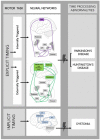Time Processing and Motor Control in Movement Disorders
- PMID: 28018198
- PMCID: PMC5149591
- DOI: 10.3389/fnhum.2016.00631
Time Processing and Motor Control in Movement Disorders
Abstract
The subjective representation of "time" is critical for cognitive tasks but also for several motor activities. The neural network supporting motor timing comprises: lateral cerebellum, basal ganglia, sensorimotor and prefrontal cortical areas. Basal ganglia and associated cortical areas act as a hypothetical "internal clock" that beats the rhythm when the movement is internally generated. When timing information is processed to make predictions on the outcome of a subjective or externally perceived motor act, cerebellar processing and outflow pathways appear to be primarily involved. Clinical and experimental evidence on time processing and motor control points to a dysfunction of the neural networks involving basal ganglia and cerebellum in movement disorders. In some cases, temporal processing deficits could directly contribute to core motor features of the movement disorder, as in the case of bradykinesia in Parkinson's disease. For other movement disorders, the relationship between abnormal time processing and motor performance is less obvious and requires further investigation, as in the reduced accuracy in predicting the temporal outcome of a motor act in dystonia. We aim to review the literature on time processing and motor control in Parkinson's disease, dystonia, Huntington's disease, and Tourette syndrome, integrating the available findings with current pathophysiological models; we will highlight the areas in which future explorations are warranted, as well as the aspects of time processing in motor control that present translational aspects in future rehabilitation strategies. The subjective representation of "time" is critical for cognitive tasks but also for motor activities. Recently, greater attention has been devoted to improve our understanding of how temporal information becomes integrated within the mechanisms of motor control. Experimental evidence recognizes time processing in motor control as a complex neural function supported by diffuse cerebral networks including cortical areas, cerebellum, and other subcortical structures (Ivry and Spencer, 2004; Coull and Nobre, 2008). Timing is an essential component of motor control primarily within two types of motor tasks: (i) when producing sequential rhythmic movements or sustained movements of a definite duration (explicit timing); (ii) when the temporal information is used implicitly, such as when coordinating our movements to those of moving objects or individuals within the external environment (implicit timing). In this review, we will provide a brief description of the neural network supporting motor timing focusing only on instrumental information to explain the link between timing and motor control in movement disorders. Then we will review available data on motor timing in Parkinson's disease, dystonia, Huntington's disease, and Tourette syndrome, and discuss how this body of evidence integrates with the available information on the pathophysiology of these movement disorders. Finally, we will discuss the translational aspects of the explored neural mechanisms with respect to future rehabilitation strategies.
Keywords: motor control; movement disorders; neural pathways; rehabilitation; timing and time perception.
Figures

References
Publication types
LinkOut - more resources
Full Text Sources
Other Literature Sources
Medical

